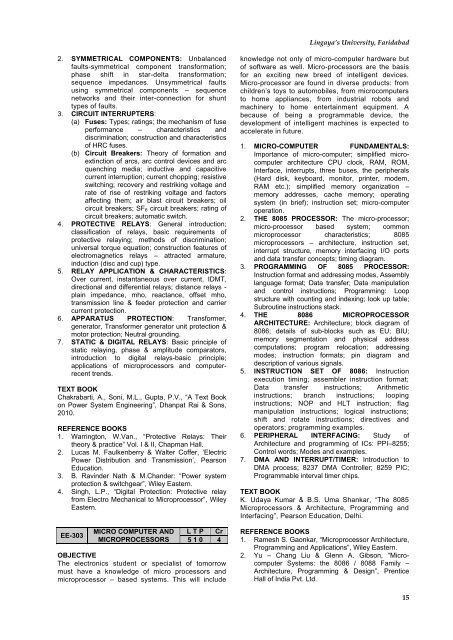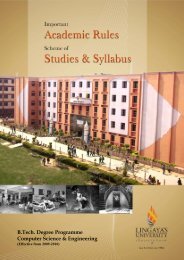Electrical and Electronics - Lingaya's University
Electrical and Electronics - Lingaya's University
Electrical and Electronics - Lingaya's University
Create successful ePaper yourself
Turn your PDF publications into a flip-book with our unique Google optimized e-Paper software.
Lingaya’s <strong>University</strong>, Faridabad2. SYMMETRICAL COMPONENTS: Unbalancedfaults-symmetrical component transformation;phase shift in star-delta transformation;sequence impedances. Unsymmetrical faultsusing symmetrical components – sequencenetworks <strong>and</strong> their inter-connection for shunttypes of faults.3. CIRCUIT INTERRUPTERS:(a) Fuses: Types; ratings; the mechanism of fuseperformance – characteristics <strong>and</strong>discrimination; construction <strong>and</strong> characteristicsof HRC fuses.(b) Circuit Breakers: Theory of formation <strong>and</strong>extinction of arcs, arc control devices <strong>and</strong> arcquenching media; inductive <strong>and</strong> capacitivecurrent interruption; current chopping; resistiveswitching; recovery <strong>and</strong> restriking voltage <strong>and</strong>rate of rise of restriking voltage <strong>and</strong> factorsaffecting them; air blast circuit breakers; oilcircuit breakers; SF 6 circuit breakers; rating ofcircuit breakers; automatic switch.4. PROTECTIVE RELAYS: General introduction;classification of relays, basic requirements ofprotective relaying; methods of discrimination;universal torque equation; construction features ofelectromagnetics relays – attracted armature,induction (disc <strong>and</strong> cup) type.5. RELAY APPLICATION & CHARACTERISTICS:Over current, instantaneous over current, IDMT,directional <strong>and</strong> differential relays; distance relays -plain impedance, mho, reactance, offset mho,transmission line & feeder protection <strong>and</strong> carriercurrent protection.6. APPARATUS PROTECTION: Transformer,generator, Transformer generator unit protection &motor protection; Neutral grounding.7. STATIC & DIGITAL RELAYS: Basic principle ofstatic relaying, phase & amplitude comparators,introduction to digital relays-basic principle;applications of microprocessors <strong>and</strong> computerrecenttrends.TEXT BOOKChakrabarti, A., Soni, M.L., Gupta, P.V., ―A Text Bookon Power System Engineering‖, Dhanpat Rai & Sons,2010.REFERENCE BOOKS1. Warrington, W.Van., ―Protective Relays: Theirtheory & practice‖ Vol. I & II, Chapman Hall.2. Lucas M. Faulkenberry & Walter Coffer, ‗ElectricPower Distribution <strong>and</strong> Transmission‘, PearsonEducation.3. B. Ravinder Nath & M.Ch<strong>and</strong>er: ―Power systemprotection & switchgear‖, Wiley Eastern.4. Singh, L.P., ―Digital Protection: Protective relayfrom Electro Mechanical to Microprocessor‖, WileyEastern.EE-303MICRO COMPUTER ANDMICROPROCESSORSL T P Cr5 1 0 4OBJECTIVEThe electronics student or specialist of tomorrowmust have a knowledge of micro processors <strong>and</strong>microprocessor – based systems. This will includeknowledge not only of micro-computer hardware butof software as well. Micro-processors are the basisfor an exciting new breed of intelligent devices.Micro-processor are found in diverse products: fromchildren‘s toys to automobiles, from microcomputersto home appliances, from industrial robots <strong>and</strong>machinery to home entertainment equipment. Abecause of being a programmable device, thedevelopment of intelligent machines is expected toaccelerate in future.1. MICRO-COMPUTER FUNDAMENTALS:Importance of micro-computer; simplified microcomputerarchitecture CPU clock, RAM, ROM,Interface, interrupts, three buses, the peripherals(Hard disk, keyboard, monitor, printer, modem,RAM etc.); simplified memory organization –memory addresses, cache memory; operatingsystem (in brief); instruction set; micro-computeroperation.2. THE 8085 PROCESSOR: The micro-processor;micro-processor based system; commonmicroprocessor characteristics; 8085microprocessors – architecture, instruction set,interrupt structure, memory interfacing I/O ports<strong>and</strong> data transfer concepts; timing diagram.3. PROGRAMMING OF 8085 PROCESSOR:Instruction format <strong>and</strong> addressing modes, Assemblylanguage format; Data transfer; Data manipulation<strong>and</strong> control instructions; Programming: Loopstructure with counting <strong>and</strong> indexing; look up table;Subroutine instructions stack.4. THE 8086 MICROPROCESSORARCHITECTURE: Architecture; block diagram of8086; details of sub-blocks such as EU; BIU;memory segmentation <strong>and</strong> physical addresscomputations; program relocation; addressingmodes; instruction formats; pin diagram <strong>and</strong>description of various signals.5. INSTRUCTION SET OF 8086: Instructionexecution timing; assembler instruction format;Data transfer instructions; Arithmeticinstructions; branch instructions; loopinginstructions; NOP <strong>and</strong> HLT instruction; flagmanipulation instructions; logical instructions;shift <strong>and</strong> rotate instructions; directives <strong>and</strong>operators; programming examples.6. PERIPHERAL INTERFACING: Study ofArchitecture <strong>and</strong> programming of ICs: PPI–8255;Control words; Modes <strong>and</strong> examples.7. DMA AND INTERRUPT/TIMER: Introduction toDMA process; 8237 DMA Controller; 8259 PIC;Programmable interval timer chips.TEXT BOOKK. Udaya Kumar & B.S. Uma Shankar, ―The 8085Microprocessors & Architecture, Programming <strong>and</strong>Interfacing‖, Pearson Education, Delhi.REFERENCE BOOKS1. Ramesh S. Gaonkar, ―Microprocessor Architecture,Programming <strong>and</strong> Applications‖, Wiley Eastern.2. Yu – Chang Liu & Glenn A. Gibson, ―MicrocomputerSystems: the 8086 / 8088 Family –Architecture, Programming & Design‖, PrenticeHall of India Pvt. Ltd.15
















